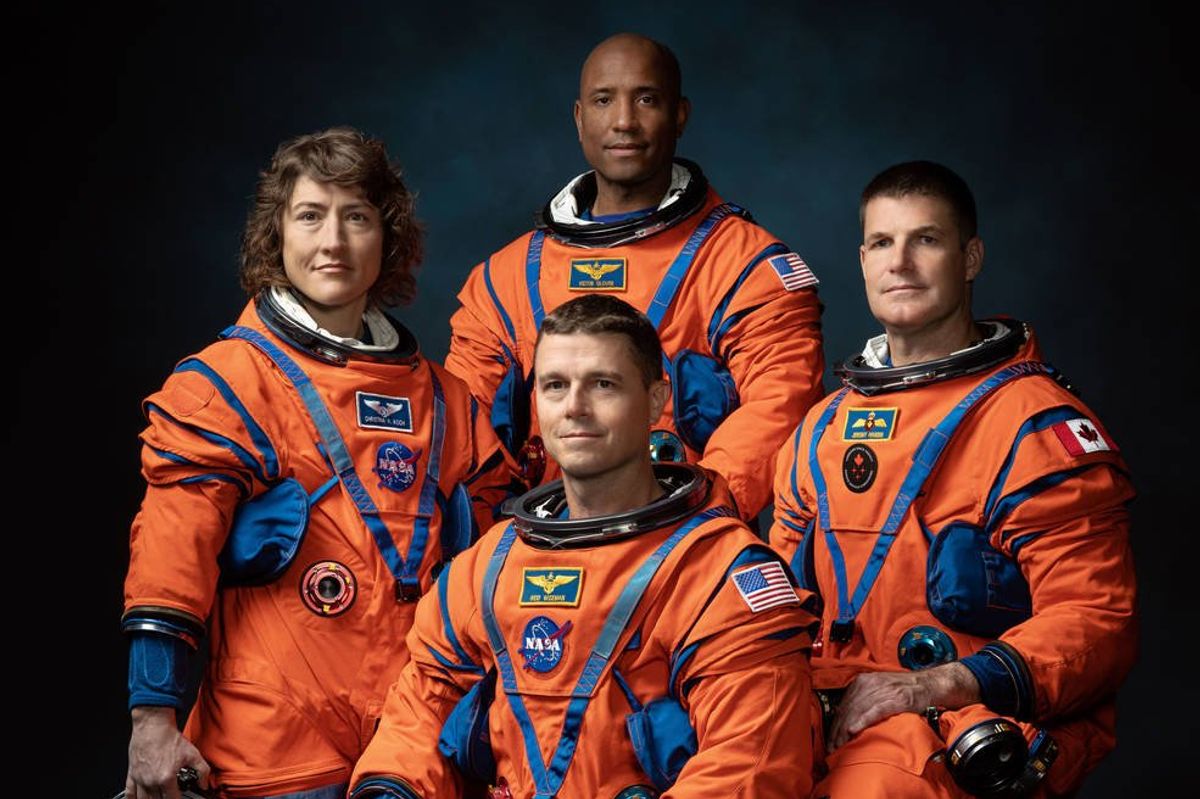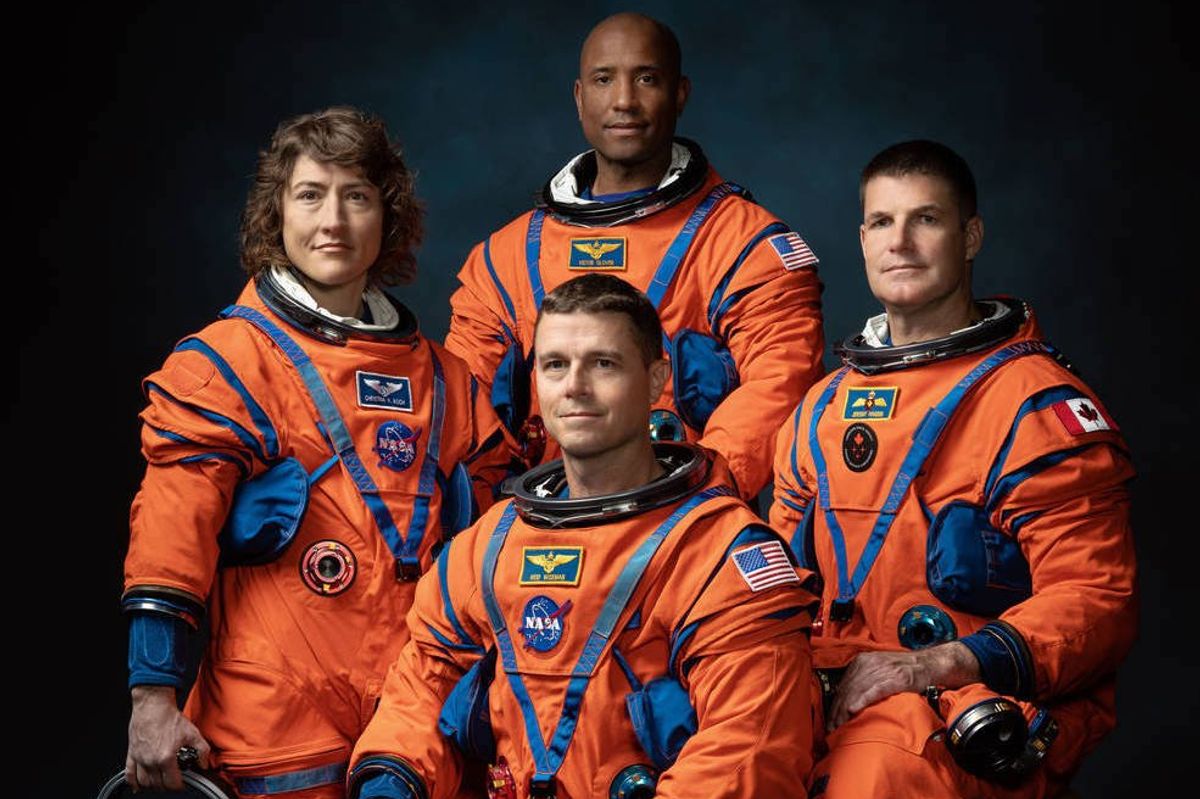The world now knows the names of the four Houston-based astronauts who will launch in the first crewed moon mission in 50 years. NASA's Artemis II will see the first woman and person of color helming a lunar voyage, a first since the agency's history.
Astronaut Christina Hammock Koch, herself part of a history-making astronaut class and first all-female spacewalk— will join Victor Glover — the first person of color heading to the moon. Rookie Canadian astronaut Jeremy Hansen rounds out the crew with Commander Reid Wiseman.
Building on the unmanned Artemis I mission to the moon that concluded in December, Artemis II is slated to launch around November 2024, per NASA. In a scene familiar to space fans, the Artemis II crew will deploy inside the cozy Orion spacecraft that will sit atop the Space Launch System (SLS) rocket from Kennedy Space Center in Florida.
Artemis II's crew will spend some 10 days in orbit and even venture farther than the 1.4 million miles logged by Artemis I, adding to the historic nature of the journey. After moon orbit, the spacecraft will return to Earth for splashdown and recovery — always a celebrated moment after the highly anticipated takeoff.
Data gathered from Artemis II will pad information from Artemis I in effort to create a permanent moon outpost. On the moon, crews will learn how to live and work away from Earth, which will pave the way for the eventual mission to Mars. A planned Artemis III mission may launch in 2025 or '26, per NASA, which picks up from the last trip, Apollo 17 in 1972. The Artemis III mission, NASA promises, will see the first woman and person of color on the moon.
CultureMap caught up with a very busy Wiseman, who is now responsible for the success of the Artemis II mission once it launches. Hailing from Baltimore, Maryland, the 47-year-old earned his master's degree from Johns Hopkins University and is a decorated naval aviator, serving in the Middle East as a fighter pilot. The Artemis II mission commander completed a 165-day trip to the International Space Station in 2014 and was most recently chief of the astronaut office, per his bio. He has two sons with wife Carol, who passed away from cancer in May 2020.

CultureMap: Congratulations, Commander. As Artemis II's leader, you are joining lunar mission commander names like the first man on the moon, Neil Armstrong, and Apollo 13's Jim Lovell. Do you allow yourself to think like that?
Reid Wiseman: Thank you. I do not allow myself to think like that. I think if you get to meet this crew — Victor Glover, Christina Koch, Jeremy Hanson — I really think we would say we want this to be so routine. We want Artemis II to be so successful and so long term that people completely forget about us. We're just that initial little stepping stone. I really hope that's the case. I am flying with an incredible group of heroes and I can't wait to go get this job done.
CM: What does it mean, as mission commander, to have the safety — and the lives — of these amazing and history-making astronauts in your hands once you launch?
RW: It means everything to me.
CM: You and the crew are so incredibly accomplished in your own individual spaces. Yet when you get to NASA — as Christina Koch once told me — you're kind of learning anew. What are you learning now?
RW: When you look at our crew, our next step is to learn about the spacecraft that will be operating in deep space. It's a very capable, very redundant, robust machine. So we have to get in the classroom, we've got to learn about all the capabilities, but we also have to get out and see the workforce.
We'll be the first humans to ever ride on this vehicle. And there's a lot of unknowns. We have a lot of systems to test. Uh One was very successful.
We need to hit the books and then we need to get in the sim [simulator], we need to practice simulations, learn how we all operate together as a team and then learn about the failure modes of the vehicle, how we can work around to keep ourselves safe and keep the mission going. And then after that, I think we'll be ready to look at Florida — and head out to the moon.
CM: Do prior lunar flight commanders and icons — like Armstrong and Lovell — serve as role models? How about the astronaut network in general?
RW: I think we look at those legends as their heroes, but they are also friends. Those folks really gave their lives to our nation and when they landed on the moon for the first time. But the amazing part for us as younger astronauts is they're still heavily engaged in everything we do right now.
I talked to Jack [Harrrison] Schmitt just a few months ago. Dave Scott still comes by every time he can to talk about geologic processes on the moon. Like these guys are our friends. It's really, really neat.
Neil Armstrong was amazing. John Young was incredible — he led our office for a number of years. Those guys are heroes to us for sure. When you look at who has taught me the most about being an astronaut, it's the folks I flew with on my first mission. It's the folks that I've worked with in the astronaut office. Now, I've seen some exceptional examples of leadership and followership and both skills are critical to be an astronaut.
CM: You learned you'll be headed to the moon — the dream adventure of billions all over the world— in the most office kind of way, we hear.
RW: Uh yeah, we all goofed up [laughs]. We missed the meeting. The chief astronaut put a placeholder on my schedule for a different topic. I was actually at a doctor's office and the doctor just walked in. So, I missed the first part of the meeting and I was able to use Microsoft Teams and dial in towards the end.
When the camera popped up, I saw the chief astronaut — who I expected to see for my meeting. But then, I also saw Norm Knight, our director of flight operations. I also saw Victor Glover and Christina Koch. And I was like, ‘oh boy, I think I just missed something big here.’
CM: Well, we've all missed meetings. But this was big — like headed to the moon big.
RW: Right [laughs]. It turned out that both Christina and Victor also missed the beginning of the meeting. So, we all showed up in perfect harmony.
------
This article originally ran on CultureMap.

 Meet the four astronauts who will return humans to the moon. Photo courtesy of NASA
Meet the four astronauts who will return humans to the moon. Photo courtesy of NASA